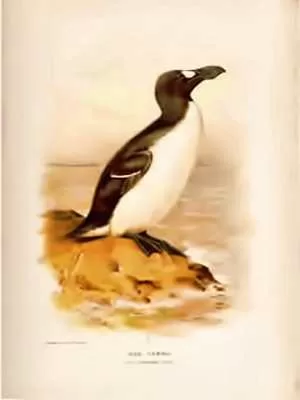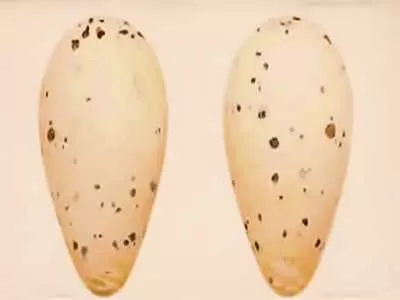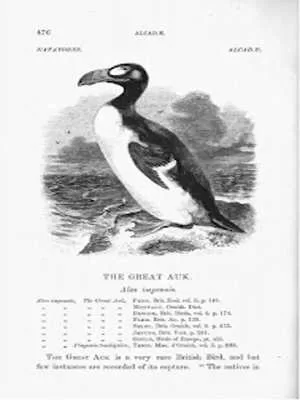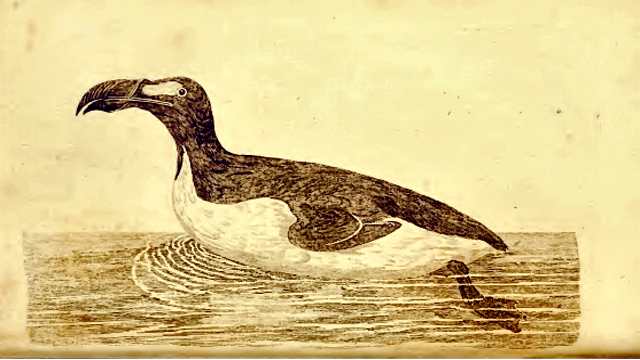The Great Auk (Pinguinus impennis), a majestic flightless bird, once roamed the North Atlantic waters, from North America to the shores of Europe. Standing at about 33 inches tall and weighing around ten pounds, this remarkable species was known for its striking black and white plumage and large, grooved bill.
Unfortunately, the Great Auk’s story is a somber reminder of how human actions can lead to the irreversible loss of a species.
Life and Habitat of the Great Auk
The Great Auk thrived in dense colonies on isolated islands, where they mated for life and laid a single egg on bare rock. These birds were not just a part of the ecosystem; they were integral to the lives and cultures of indigenous maritime peoples who relied on them for food and resources. The Great Auk was also known as the Garefowl, a name derived from the Icelandic word “Gyer,” meaning “spear,” likely referencing the shape of its beak.

As European explorers ventured into the Americas, they quickly recognized the Great Auk as a valuable resource. The birds were hunted for food, used as fishing bait, and their feathers were sought after for stuffing quilts and cushions. This exploitation marked the beginning of a tragic decline in their population.
Impact of the Feather Trade
The demand for Great Auk feathers led to a significant decrease in their numbers. Despite early conservation efforts, such as the implementation of laws aimed at protecting the species, these measures proved largely ineffective. Captain George Cartwright’s journal entry from July 5, 1785, vividly describes the hunting practices of the time:
“When the water is smooth, they make their shallops fast to the shore, lay their gang-boards from the gunwale of the boat to the rocks, and then drive as many penguins on board as she will hold; for the wings of those birds being remarkably short, they cannot fly. But it has been customary of late years for several crews of men to live all the summer on that island, for the sole purpose of killing birds for the sake of their feathers, the destruction which they have made is incredible.”

As the Great Auk population dwindled, ornithologists and collectors rushed to acquire specimens before they vanished entirely, further exacerbating the decline. The distinguished ornithologist William Yarrell noted the Great Auk as “very rare” in the first edition of his A History of British Birds (1843), highlighting the alarming trend of their disappearance.
The Last Days of the Great Auk
In 1835, a small colony of about fifty Great Auks was discovered on Geirfuglasker, a tiny volcanic island off the coast of Iceland. However, after volcanic activity disturbed their habitat, the remaining birds relocated to Eldey, a nearby islet. Tragically, it was here that the last two Great Auks were captured on June 3, 1844. Naturalist John Wolley, who had traveled to Iceland with fellow ornithologist Alfred Newton, documented the events surrounding their capture. Wolley’s account reveals the vulnerability of the Great Auk:

“The Gare-fowls showed not the slightest disposition to repel the invaders, but immediately ran along under the high cliff, their heads erect, their little wings somewhat extended. They uttered no cry of alarm and moved, with their short steps, about as quickly as a man could walk.”
After Wolley’s untimely death in 1859, Newton presented his research in the ornithological journal The Ibis, further solidifying the Great Auk’s tragic fate. In a revised edition of his History (1871), Yarrell declared the species extinct, noting that only a handful of specimens remained in existence.
Legacy of the Great Auk
The Great Auk’s extinction serves as a cautionary tale about the consequences of human greed and exploitation. By the early 1900s, the value of Great Auk specimens skyrocketed, with eggs selling for over £300 and mounted birds fetching prices as high as £9,000 in 1971. This stark contrast between the price of a specimen and its ecological value underscores a troubling trend in humanity’s relationship with nature.
Modern conservation efforts have been informed by the lessons learned from the Great Auk’s demise. Organizations worldwide now work tirelessly to protect endangered species and their habitats, advocating for sustainable practices that prioritize the well-being of wildlife. The story of the Great Auk reminds us of the importance of preserving biodiversity and the delicate balance of ecosystems.
Conclusion
The Great Auk’s tragic story is a powerful reminder of the impact of human actions on the natural world. As we reflect on the past, it is crucial to recognize the importance of conservation and the need to protect vulnerable species from the same fate as the Great Auk. By understanding the consequences of our choices, we can work towards a more sustainable future, ensuring that the lessons of history are not forgotten.
In a world where the price of a specimen can overshadow its true value, it is our responsibility to advocate for the protection of wildlife and to cherish the beauty of the natural world. The Great Auk may be gone, but its legacy lives on, urging us to be better stewards of the planet and to value the irreplaceable treasures of our ecosystems.

